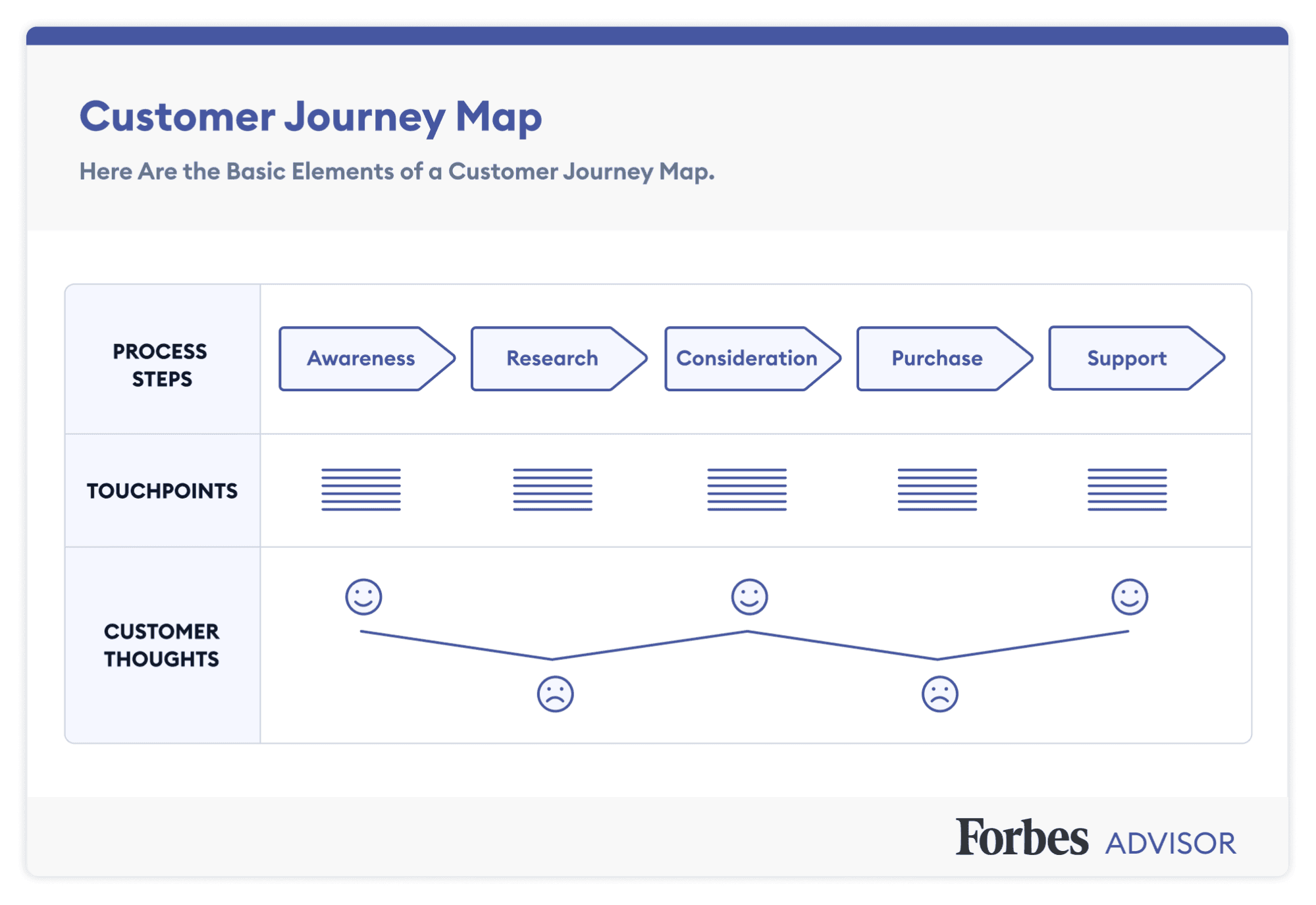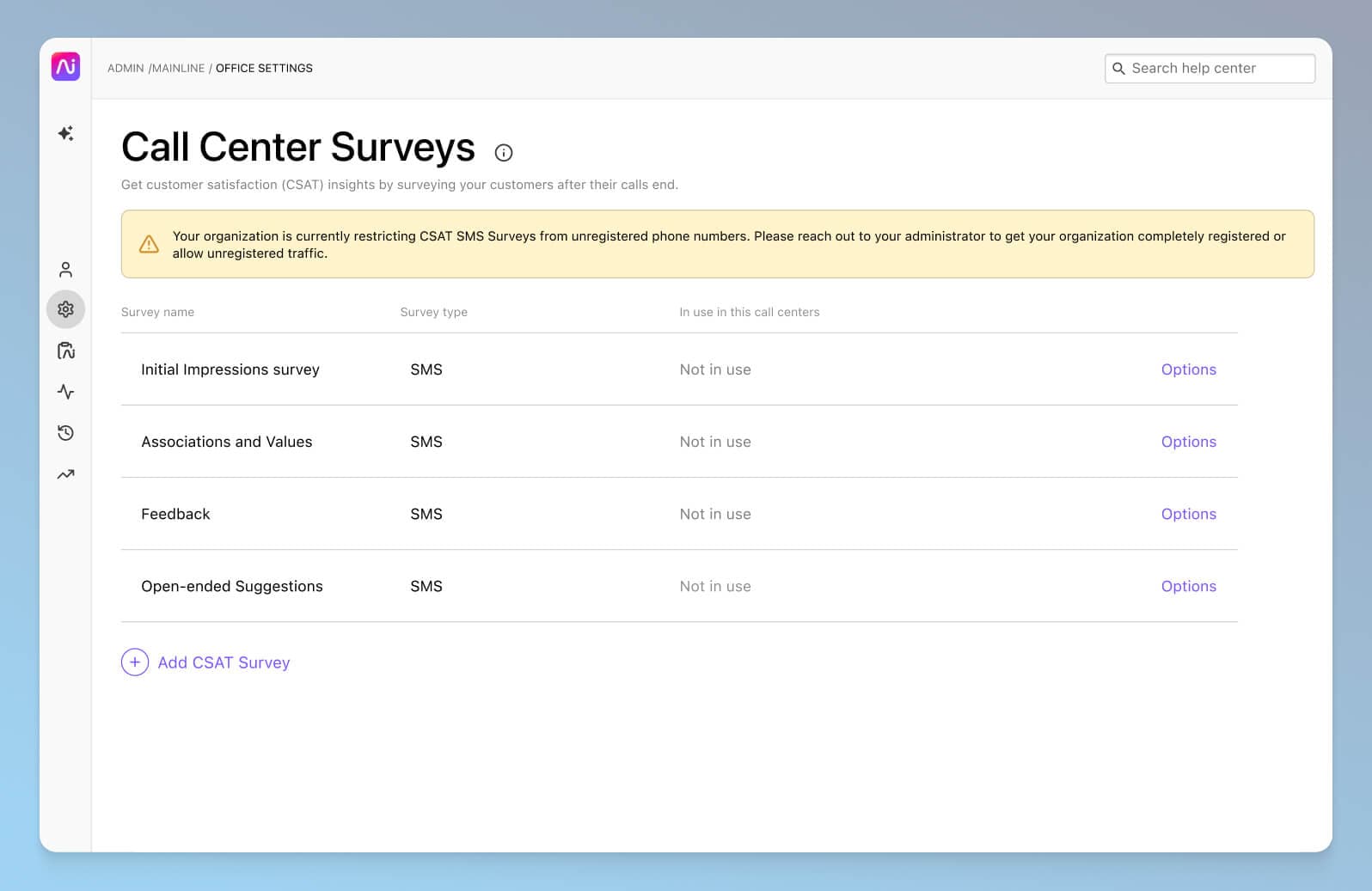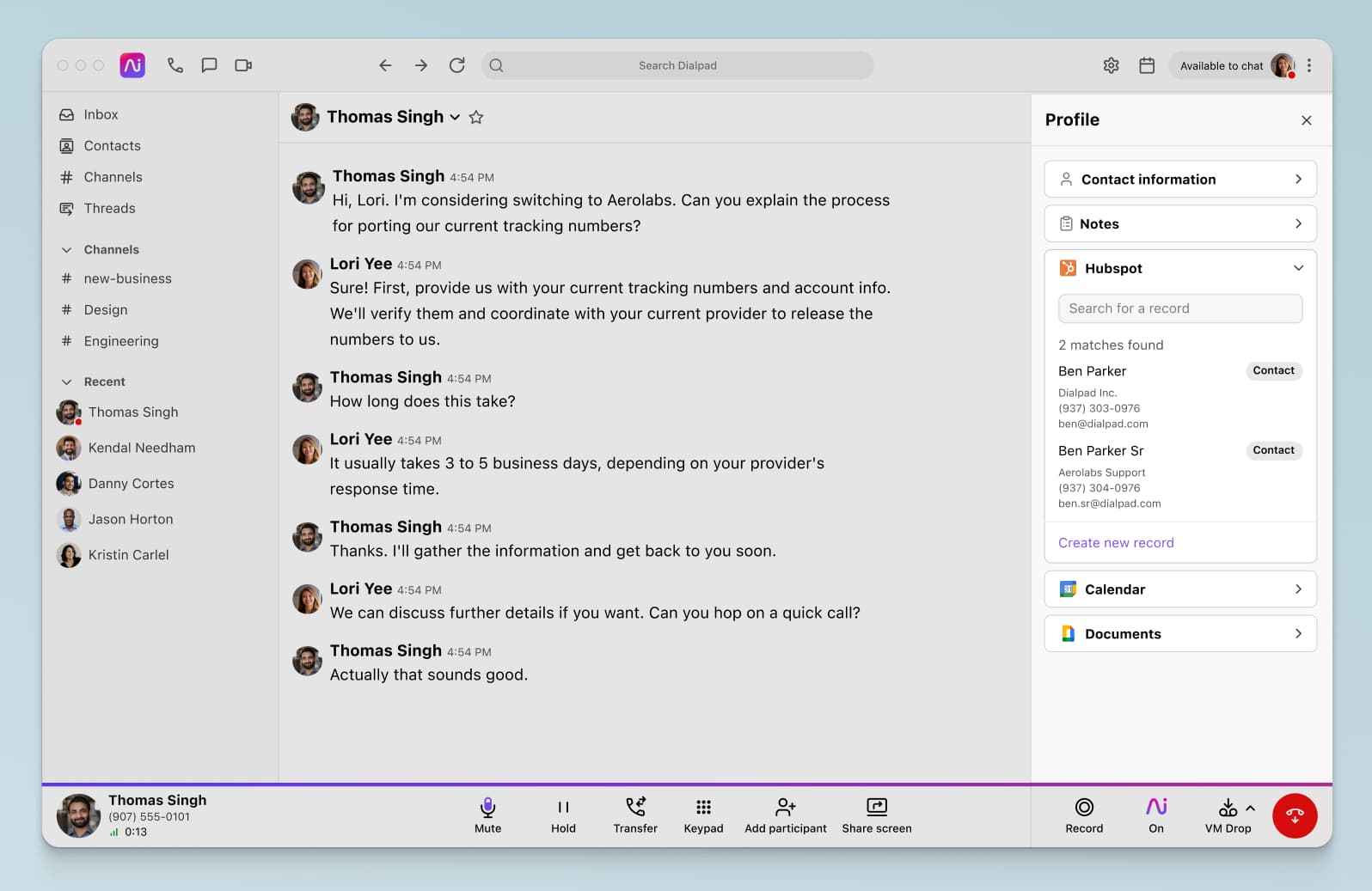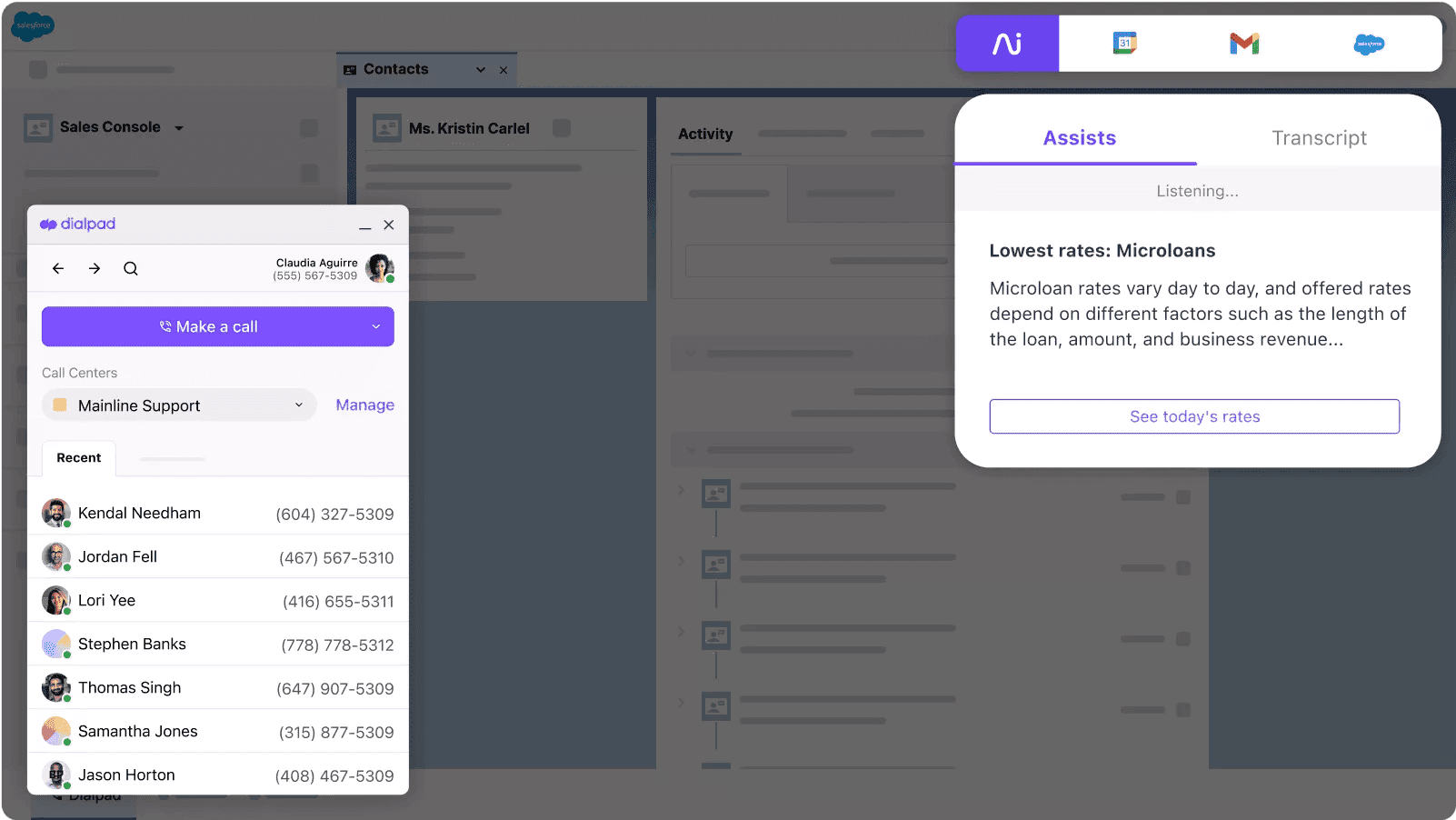A guide for the digital world
Customer journey management
Need help managing your customer journeys? Dialpad's AI-powered customer engagement platform lets agents and supervisors handle all your communication channels in one place, and even lets you orchestrate an omnichannel experience that gets your customers what they need—fast. Book a product tour to see how it works!

The customer journey isn’t what it used to be.
Before, customers might hear about your business in an ad, walk by your store, come inside and have a look around—and maybe walk out with a purchase. If they like you (or if you have a truly exceptional customer experience), they might come back.
Today, it’s a little more complicated.
Your customers (and potential customers) aren’t just coming into your store, if they drop by at all. Instead, they’re browsing your website, chatting with you on WhatsApp, and maybe even calling you.
That’s a lot of touchpoints—and a lot of opportunities for things to go wrong (or right, if you’ve got a great customer journey management strategy).
So what does good customer journey management actually look like?
Well, you’ll need to have a good understanding of customer behavior. You’ll also need to know how it impacts your business goals. Not to mention you have to be constantly on top of key metrics like churn and retention.
In this guide, we’ll walk you through all of these steps.
But first, a refresher.
A quick refresher: What is a customer journey? How is it different today?
At its most basic level, a customer journey is the sequence of steps that a customer takes as they go from a lead or a prospect to a paying customer, to potentially even an advocate for a business.
Many people think of this as being linear, but that’s not realistic today, with so many digital channels. Whereas before, the journey might look something like “customer sees your ad, walks into your store, then buys your product,” that might today look like “customer sees your ad, browses your website, doesn’t do anything, sees another ad, follows your company on Instagram, sees a sponsored ad on Instagram, then buys your product.”
Whew. Sounds complicated, but it’s not uncommon. In many cases, it’s common for customers to back-track or retrace their steps a few times before finally giving you their credit card info and making the purchase.
👉 Dialpad tip:
You’ll also hear a lot about “omnichannel” customer experiences today. In this case, an omnichannel customer service experience means that not only are your customers able to reach out to you through different channels like social media and phone calls, but also that contextual data and relationship history is automatically synced between all those channels. Your customer support team, for instance, would be able to see all of a customer’s past conversations with your business, whether they’re from WhatsApp, Facebook, or live chat (or all three).
Okay, so what is customer journey management?
Customer journey management is essentially the art (and science) of creating a smooth and frictionless path for people to become your customers and grow your business.
It can be a pretty complicated process. For example, you have to:
Understand customer expectations. What level of service and what quality of product do you need to provide? (Customer expectations and customer needs aren't always the same things!)
Be familiar with each customer touchpoint that people are using to reach you. If most of your customers try to reach you through phone calls, and you don't get a lot of questions or action on social media, your customer support team's structure should support those nuances.
Have an optimization plan to continuously improve and refine that journey. Think of it as experience management. Your most valuable customers aren't the one-off customers who buy once and never come back. Every single customer is an opportunity to build a long-term relationship with someone who not only loves your products, but might also tell their friends and network about how awesome you are.
And that's just to name a few of the tasks!
In general, it’s important to focus on the whole journey across different touchpoints over time, rather than just optimizing single interactions. If you've got a hundred customers complaining about one product versus a single other complaint that's a rare edge-case, fixing the former should be a priority.
What are the benefits of doing customer journey management well? (aka. Why should you care?)
Yes, it can be a bit of a process, and you’ll need to dedicate some people and resources to it, but the payoffs can be significant if you can manage and do regular optimizations for your customer journey.
A better customer experience
One of the biggest benefits of effective customer journey management is, generally, a better experience for your customers. And that's because you'll have a deep understanding of almost everything about them. You should know things like their favorite touchpoints for communicating with you, what their most common pain points are, what your retention rates look like, and a lot more.
(Not to mention the fact that an improved customer experience means your customers will stick around for longer—and spend more money with you. 91% of customers say they’re more likely to make another purchase after a great service experience.)
👉 Fun fact:
Rently, a company that provides property managers with self-touring and smart home technology and support, used its contact center platform to help its agents provide a better customer experience. In fact, Sahil, its Head of Customer Care, said, “One thing that I love in Dialpad is the call journey feature, where you can see where calls were routed, forwarded, and changed. It’s beautiful, and brought a lot of peace of mind to our call center operations—there’s no more wondering where a call came from or how someone got it.”
Lower operating costs
Another byproduct of having a good customer experience is that it tends to increase retention and reduce churn. The result: You don't have to spend as much money trying to replace the customers you lost by winning new business.
(A quick online search will show a ton of research and statistics about how it's much cheaper to retain customers compared to getting new ones.)
Having the right tools here, whether it's a robust contact center platform or an automation tool, can be very useful. For example, Dialpad's customer engagement platform has a built-in AI: Dialpad Ai. Not only can it transcribe calls—in real time—it also lets supervisors create Real-time Assist (RTA) cards with tailored notes that pop up on agents' screens whenever a keyword or phrase is spoken:

This means that even new hires can hit the ground running and get customers the answers they need quickly. No hanging around in a call queue, and no need to explain the issue over and over again after being transferred to different agents.
Happier customers, lower churn, higher retention—which together can seriously lower your operating costs.
Dialpad helped us catch a lot of things. A big problem we used to have was calls getting transferred to the wrong place… now we’re able to identify those and can get ahead of it. We can see call journeys, catch those transfers, and educate our staff on the appropriate places to route those calls.
Jon DiBiasio
I.T. Director at Fenway Health
More revenue
And of course, on a related note, a good omnichannel customer journey solution or strategy can ultimately boost your company’s profits in a variety of different ways.
On top of reducing churn, those higher levels of customer engagement also tend to result in nice side-effects like more upsell and cross-sell opportunities.
Why? Because if you understand your customer’s journey well, you would also know when is the best time to send an email with discounts or offers to encourage them to make a follow-up purchase (e-commerce businesses are masters at this). And what's more, you'd also know how to create a personalized experience to pull this off (with minimal effort, especially if you have a good email automation tool).
(So it turns out that we might be able to put a price on the value of customer journey management after all.)
✨ GET THE CONTACT CENTER PLAYBOOK
It breaks down everything you need to know, from setup to staffing to optimizing—with examples from real contact center teams across different industries.
5 customer journey tips to optimize support in your contact center
So, how can you design a journey that lets your agents meet customer needs at scale and provide an omnichannel experience that spans everything from social media to phone calls? Let’s look at a few ways to do it.
1. Map out your customer journey
Customer journey mapping is an essential part of providing a good customer experience because it helps you and your wider team visualize how your customers get from one touchpoint to another.
To really start to understand the logic behind customer behavior, you have to compare this map with what your team is seeing in real life. For example, why are you getting swamped with orders on the phone lately when people could just be buying on your website? Maybe after some investigating, you notice your website has a bug or the user experience isn't great. Now you can make a plan to fix that part of the customer journey.
Here’s an example of a customer journey map that you can use as a template:

As you map this out, make sure to take your journey analytics into account. Otherwise, you might have a great looking journey map, but no idea whether it's effective or how it's impacting business outcomes (if it's doing that at all). Define your metrics or key performance indicators (KPIs)—for example, if an e-commerce brand learns that customers are abandoning their carts at checkout, they might take a closer look at that flow and maybe adjust their delivery pricing.
With Dialpad, you can create CSAT (customer satisfaction) surveys from your online dashboard, and set them to trigger automatically after a customer call is done. This way, the interaction is fresh in your customer's mind and you can get actionable insights about whether you need to make any optimizations to that phone experience, based on actual customer feedback.

👉 Dialpad tip:
Involve your sales and marketing teams in this project to get a full 360-view of the customer journey.
2. Find ways to make your organization more customer-centric
Okay, everyone talks about being "customer-centric," but what does that really mean? It's a big umbrella term, and under it are many different tactics and angles you can focus on.
From having a Voice of the Customer program, to making sure your contact center software or provider helps eliminate silos when it comes to customer data (essentially, by making that information easily accessible to different teams), there are many different approaches you can take.
Depending on how many channels your customer engagement spans, you may need a journey orchestration tool or strategy. Journey orchestration is pretty much what it sounds like—it's a more strategic and proactive approach that can be considered a part of customer journey management.
You're trying to ensure coordinated, consistent actions, and there are actually some AI and machine-learning-powered tools that can help with this! For example, Dialpad's contact center platform lets you take full control of journey orchestration and plan how you want to guide customers across touchpoints like social media and phone calls. Dialpad Ai can help determine intent based on the customer's questions or messages, and send them to the best agent or FAQ article. It's easy, there's no coding needed, and you can do it all from one platform.
3. Make sure your customer experience tools are integrated
Integrations are essential. Most contact center teams will have a contact center platform, a WEM tool, and likely other tools for customer journey management too.
One of the big benefits of having integrations is that it reduces data entry and other low-value, repetitive work that your agents have to do. Logging calls and other activities? No need, Dialpad's integrations with CRMs like Salesforce and HubSpot can do that automatically for you:

And not only that Dialpad's Salesforce integration also works on the mobile app—not just on desktop—and can embed its Real-time Assist (RTA) card feature in the CRM, which means if you're on a call with a customer and a tricky topic or question comes up, Dialpad will automatically pop up an RTA card with tailored notes on the agent's screen:

Even better than integrations? Having robust, versatile tools that can do multiple things well. For example, with Dialpad you're getting not only a contact center platform (many of which just let customer experience teams do basic phone calls and call routing), but also journey orchestration functionality in one dashboard. Instead of having to pay for multiple disparate tools, you're getting everything in one place. It makes life easier for your agents and end users (and keeps your teammates in Finance and Legal happy because there's less paperwork and fewer invoices).
4. Identify key customer behaviors
Understanding important triggers for your customers as they interact with your business will help you tailor your products and services to them. This is especially important if you have different customer personas, because it’ll help you provide a more personalized customer experience—which is not only nice for them, but can also help you increase cross-sell and upsell opportunities.
For example, you could look at the different paths they take across your omnichannel touchpoints. Are they asking for product support through social media channels like WhatsApp? Or do they prefer to use live chat on your website? What are your surveys saying about customers’ perceptions of your brand?
These are all important questions to ask as you make continuous optimizations to your customer journey.
🔎 A closer look:
See how D2C apparel brand Tecovas uses Dialpad’s Kustomer integration to put customer data right at their agents’ fingertips, letting them they quickly see past orders, identify VIP customers, and find opportunities for upselling.
5. Define the success metrics
“Success” can mean different things to different businesses and customer experience teams. Does success for your team mean a customer completing a purchase? Or paying a bill?
This is essential to see whether your customer journey management is working and if it's positively influencing business outcomes. There are all sorts of metrics you can look at, from conversion rate to NPS (net promoter score), to CSAT.
The right customer journey solutions: The first step to effective customer journey management
When it comes to effective customer journey management, it can be overwhelming at first because there are so many potential touchpoints and angles you can start from.
If you have the right tools (a good contact center platform and ideally a journey orchestration tool at the minimum), you'll have a much easier time creating a good customer experience.
Want to provide more personalized experiences at scale...
... And make better use of your customer data, and increase retention? Book a demo to see how Dialpad can help your business do exactly that, or take a self-guided interactive tour of the app on your own first!
